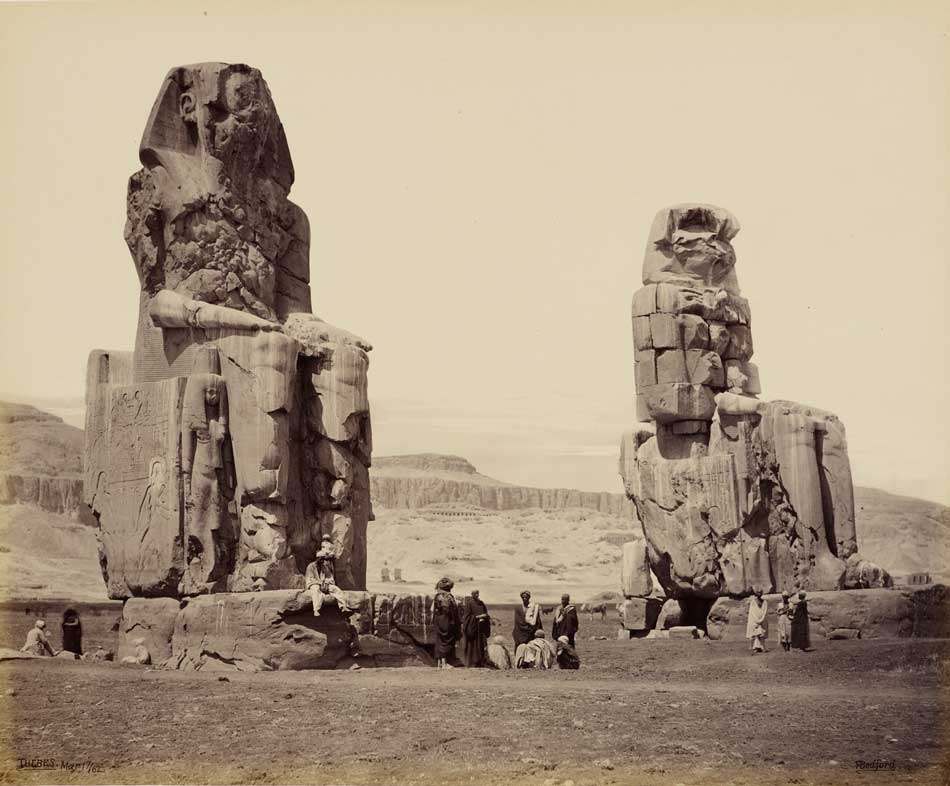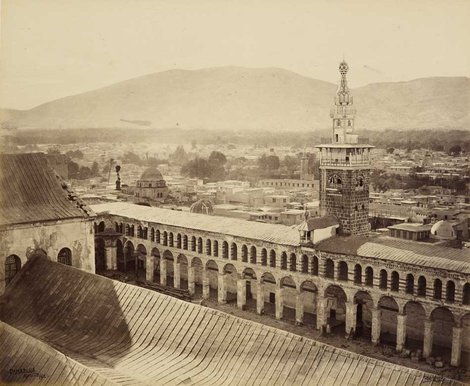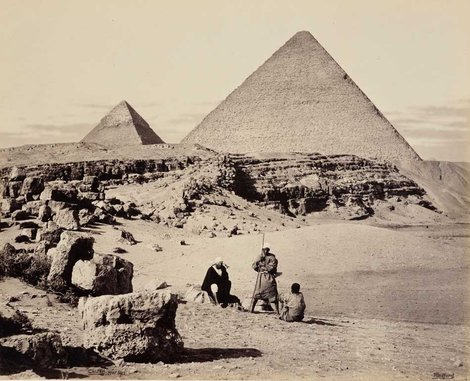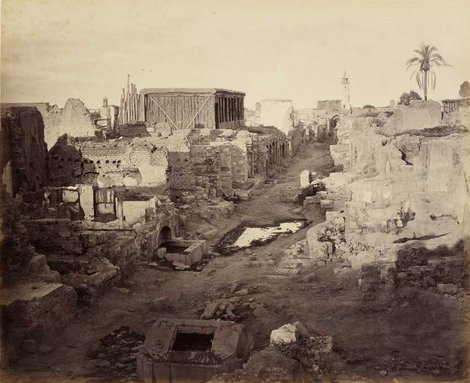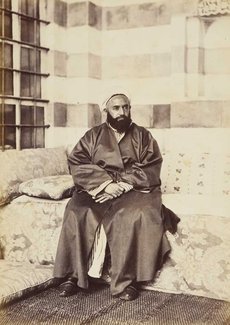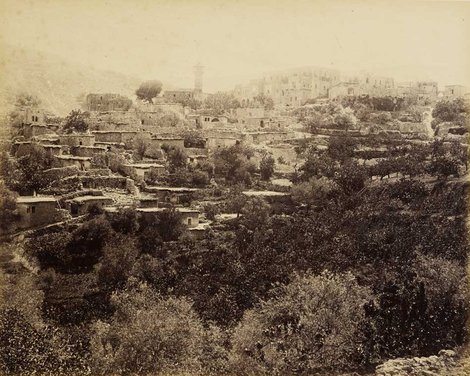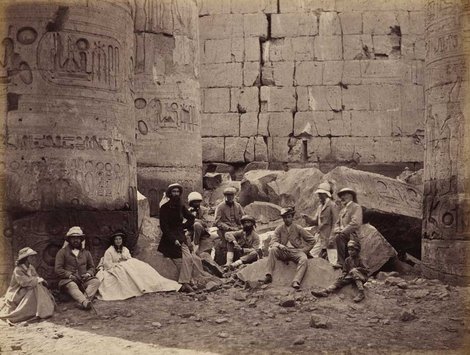In February 1862 the eldest son of Queen Victoria, the Prince of Wales and future King Edward VII, embarked on a four-and-a-half month journey through the Middle East. The royal party followed what was on the face of it a conventional itinerary, sailing from Venice down the Dalmatian coast on the royal yacht Osborne to Alexandria, cruising up the Nile to Aswan to view the sites of ancient Egypt, crossing to Jaffa for a tour of the Holy Land, then returning to England via the Ionian islands and Constantinople.
Among the party—included at the last moment—was the photographer Francis Bedford, who in over 190 prints produced one of the earliest photographic records of the region. These sepia studies, soft-lit yet rich in detail, were achieved with a cumbrous caravan of lenses, tripods, chemicals, plates, and a portable darkroom. His subjects were mostly but not all the sites of ancient or biblical significance that Western visitors already favored: the ruined survivors of a stupendous past that they could half claim for themselves.
A case can be made that such a project—whether embracing the Roman ruins of Baalbek or the village of Bethlehem—was the selective appropriation of a classical and Christian heritage: a tangential colonial enterprise. But Bedford’s subjects include too the massive and less ownable detritus of the Egyptian kingdoms, and the mosques of Mameluke Cairo and Ummayyad Damascus. The past, as often, was a slippery possession.
Royal Collection Trust
Francis Bedford: Part of the Great Mosque from the Minaret, Damascus, April 29, 1862 (click to enlarge)
Bedford, of course, was following in the footsteps of a generation of enterprising scenic artists such as David Roberts, who invested their lithographs or watercolors with the detail and perspective of romantic sensibility. And photography, struggling in its infancy for a respected place among the arts, often used identical scenes. But within the photographic community the debate was lively between those who embraced the medium for its literal objectivity, and those who favored it as a creative genre. Its innovative potential is apparent when one compares Bedford’s plates with the lyrical work of such topographic artists as Edward Lear and William Henry Bartlett, who depicted (or imagined) the same places. Bedford’s training had been in architectural draftsmanship, and his studies of buildings convey not only marveling interest, but also a restrained respect for balance and proportion.
Yet in his studies of architectural splendors, the contemporary inhabitants—peasants, caretakers, laborers—provide merely a sense of proportion and a touch of oriental romance. The torpor of the declining Ottoman empire is palpable in his rare group photographs—unreliable Ottoman mercenaries or ragged Albanian water-carriers—as it is in the empty-looking villages of Hebron or Bethany. Even the streets of Cairo appear deserted. And there are no Jews.
In a sumptuous new record of his work on the royal journey, Cairo to Constantinople: Francis Bedford’s Photographs of the Middle East, published by the Royal Collection Trust with a main text by Sophie Gordon, the remoteness of Egypt and the once-named Holy Land is evident from the first. On the jacket the pyramids of Giza—today all but engulfed by the suburbs of Cairo—rise instead from an empty, rock-strewn wasteland.
Royal Collection Trust
Francis Bedford: Pyramids of Cheops and Cephrenes, Giza, March 5, 1862 (click to enlarge)
This sense of near-timeless distance is shared by other photographs from the expedition (which were first shown the same year). One of Bedford’s most notable coups was permission to enter the Haram al-Sharif in Jerusalem, the “Noble Sanctuary,” and to photograph the Dome of the Rock and the al-Aqsa Mosque at close quarters for the first time. The Dome’s original gilt cupola had been stripped long before, and its present bronze aluminum cover was not yet in place; the ancestors of the Persian tiles that now coat the building had fallen from walls of gaping plaster and nail-holes. The shrine, in Bedford’s lens, has a mellow, somber beauty.
Bedford’s second coup was to photograph the aftermath of a still bitterly felt tragedy in Syrian and Lebanese history. In 1860 the rankling enmity between the landowning Druzes and Maronite Christian peasants in Lebanon spilled over into Damascus, where Muslims and Druzes, abetted by the Ottomans, invaded the Christian Arab quarter and slaughtered some 2,500 people over three days. Two unique photographs reveal a spectral Christian quarter of roofless walls and rubble. The Street Called Straight is a gutted artery. The Greek Church of St. Mary, where several hundred burnt to death, is a skeleton of shorn arches and columns.
Royal Collection Trust
Francis Bedford: The Street Called Straight, Damascus, April 30, 1862 (click to enlarge)
A further photograph depicts a quiet Lebanese village, terraced with orchards. Bedford has labeled it Hasbeiya, Scene of the Massacre, and its idyll hides a premeditated slaughter of Christians less than two years before. So does the photograph of Mount Hermon in which the ruined terraces that spread beneath the snow-fields had been farmed by Maronites, since annihilated.
Advertisement
At such moments, the twenty-year-old Prince of Wales’s dutifully-logged journal livens into sympathetic disgust. But what effect this whole educational sortie had on the prince—an affable philistine—is not disclosed. Once, at least, he protested at the prospect of yet another “tumble-down old temple,” and was keener on shooting crocodiles and almost any other game. (By the end of the tour he had dispatched gazelles, vultures, hares, larks, geese, owls, crows, and even lizards.)
The text of From Cairo to Constantinople, by Sophie Gordon with an introduction by John McCarthy and essays by Badr El Hage and Alessandro Nasini, gives too slight an account for this multi-faceted journey. Many photographs cry out for enriching explication. Bedford’s scene inside the Arab citadel at Hasbaya, for instance, only makes sense in the context of the atrocious massacre perpetrated there less than two years before; but this goes unmentioned. In a rare photographic portrait of Emir ‘Abd al-Qadir, leader of a long and widespread insurrection against the French in Algeria, the great warrior is identified only as a protector of the Christians.
The royal journey’s motive, too, may have been more complex than suggested. Ostensibly it was a private, informal expedition. It was urged by Queen Victoria for her son’s education (pretty much a lost cause, according to his guardian) and she ordered that the Prince go incognito, with no ceremonial encounters. But the itinerary seems to have been planned above all by the Prince Consort Albert, as a diplomatic initiation for the young man and to foster goodwill.
Ever since Napoleon’s aborted invasion of Egypt, the British had been more sharply conscious of the vulnerability of the strategic and trade passage to India. The Middle Eastern interests of the European powers and of the United States became apparent in the strategic stationing of consuls and the increasing presence of missionary churches. Egypt, since the emergence of Muhammed Ali’s dynasty in 1805, was stirring out of its feudal sleep, and by the time of the Prince’s journey the Frenchman de Lesseps was constructing the Suez Canal: an idea that had been envisioned by Napoleon. Among the prince’s informal encounters were those with the emperor Franz Joseph of Austria, the German-born royalty of Greece, the viceroy of Egypt, Said Pasha, and even the Ottoman Sultan Abdul-Aziz.
Among the party that accompanied the prince—they appear in several shots—is not only Robert Bruce, his dour guardian, and Canon Arthur Stanley, his reluctant cultural mentor, but the dark-bearded figure of Robert Meade, one of the British negotiators with the Ottomans after the Druze-Maronite atrocities. Hence, perhaps, Bedford’s sensitivity to the sites of massacre. (The British had favored the Druzes in these grisly episodes, while the French had sided with the Maronites.)
Royal Collection Trust
Francis Bedford: Hasbeiya, Scene of the Massacre, April 26, 1862 (click to enlarge)
The oddest lacuna in this handsome book is any mention of the scandalous background to the prince’s dispatch from England in the first place. At the end of the previous year he had dabbled in military life at the Curragh camp in Ireland, consorting with a clique of young Guards officers who encouraged him into bed with an enterprising young seductress named Nellie Clifden. The callow prince momentarily delighted in her, and she followed him to London. Rumors were flying—it was said that she was naming herself “the Princess of Wales”—and news of the affair at last reached the prince’s severely ill father, Albert, whose reaction was puritan outrage. Prince Albert’s background goes some way to explain his horror: his own father had been a callous philanderer and his mother famously adulterous. The letter he wrote to his son is full of anguish and panicky imaginings. Nellie might have a child, he wrote, and attribute it to Edward:
If you were to try to deny it, she can drag you into a Court of Law to force you to own it and there, with you in the witness box, she will be able to give before a greedy multitude disgusting details of your profligacy…. Oh horrible prospect, which this person has in her power to realize!
Within two weeks the Prince Consort was dead of typhoid, and the hysterical Queen blamed his death on their son. She could not bear to look at him, she wrote. It was good that he go away. Only as they parted did some semblance of pity return. “Poor Bertie was very miserable…and so was I.”
Advertisement
So the prince departed for an adventure that at first filled him with indifference. Its political uses were opaque and perhaps incidental. His natural buoyancy, it seems, recovered not at consorting with foreign rulers, nor at the unpalatable (to him) makeup of the royal party, still less at the sight of pyramids or temples, but at the prospect of shooting crocodiles.
Royal Collection Trust
Francis Bedford: The Prince of Wales With Group, in the Hypostyle Hall, Temple of Amun, Karnak, March 16, 1862 (click to enlarge)
Sophie Gordon’s Cairo to Constantinople: Francis Bedford’s Photographs of the Middle East, with an introduction by John McCarthy and contributions from Badr El Hage and Alessandro Nasini, is published by the Royal Collection Trust and distributed in the United States by the University of Chicago Press.


